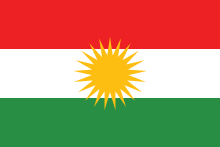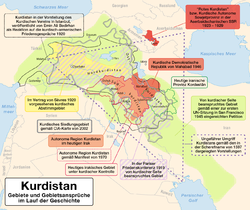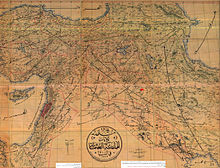Kurdistan
![]()
The title of this article is ambiguous. For the autonomous region in Iraq, see Kurdistan Autonomous Region; for other meanings, see Kurdistan (disambiguation).
Kurdistan (Kurdish کوردستان Kurdistan; Arabic كردستان, DMG Kurdistān; Persian کردستان Kordestān; Turkish Kürdistan) is an unspecified area in the Near East considered to be the historical settlement area of the Kurds. Some of the states over which this area extends avoid the term Kurdistan or even forbid its use. Its use, on the other hand, is promoted or demanded by broad sections of the Kurdish population. Depending on the definition, the entire Kurdish settlement area covers 440,000 to 530,000 km2 and is distributed among the states of Turkey, Iraq, Iran and Syria. In addition to Kurds, Arabs, Persians, Azerbaijanis, Turks, Turkmen, Armenians and Assyrians/Aramaeans also live in these areas.

Flag of the Kurds

Expansion of Kurdistan and territorial claims in the course of history
On the history of the term Kurdistan
The term Kurdistan first appears as a designation for an area in the Armenian chronicle of Matthias of Edessa. It designates with K'rdstanac an area between Diyarbakır and Siverek. The chronicle describes in three parts the events of the years 952-1136. As an administrative unit, Kurdistan emerged as a province of the Seljuk Empire at the time of Sultan Ahmad Sandshar (r. 1097-1157). It included the present-day Iranian territories of Hamadan, Kermānshāh, Dinawar, and Sanandaj. Hamdollah Mostowfi enumerates the 16 cantons of this province in his 1349 work Nuzhat al-ḳulūb.
In the Sherefname, the Luri are also counted as part of Kurdistan. In the 4th volume of his Seyahatnâme, the Ottoman traveler Evliya Çelebi lists nine Vilâyets that belonged to Kurdistan at the time: Erzurum, Van, Hakkari, Diyarbakir, Jazira (Cizre), ʿAmādiya, Mosul, Shahrazūr, and Ardalan. Rivalry between the Ottoman Empire and the Safavids led to the partition of Kurdistan. In the 17th century, on the Ottoman side, only the districts of Dersim, Muş and Diyarbakir belonged to the Vilâyet Kurdistan. In the 16th century, Kurdistan was administratively limited to the Ardalan region in the Safavid domain. Hamadan and Lorestan were separated.
In a 1526 letter from the Ottoman Sultan Suleyman to the French King Francis I, Suleyman names Kurdistan as part of his domain.

Kurdistan (shown here in the center of the map as کردستان) on an Ottoman map from 1893.
Geography
The borders of Kurdistan cannot be defined precisely. For one thing, apart from the Autonomous Region of Kurdistan in Iraq and the Iranian province of Kordestān, there is no political territory and no administrative unit of Kurdistan. To make matters worse, there is no ethnically homogeneous compact settlement area of Kurds. The borders of Kurdistan are therefore highly disputed.
Kurdistan lies between 34 and 40 degrees north latitude and 38 and 48 degrees east longitude (37° N, 43° E3743coordinates: 37° N, 43° E). It stretches across eastern and southeastern Anatolia - more specifically from İskenderun and the Taurus Mountains up to Mount Ararat - to Lake Urmia in Iran and includes the region of the Zagros mountain range, i.e. northern Iraq and western Iran, as well as parts of northern Syria. Kurdish activists have increasingly used the terms Eastern Kurdistan, Northern Kurdistan, Southern Kurdistan, and Western Kurdistan for the Kurdish regions belonging to Iran, Turkey, Iraq, and Syria since the 1980s. The following is a characterization of the individual parts of Kurdistan according to the states to which the regions belong.
Turkish part
The Turkish part makes up about 25% of the national territory, depending on the definition. The center of gravity extends geographically from the province of Gaziantep to Hakkâri and from Malatya to Kars. In addition, Kurds (Central Anatolian Kurds) have been living in Central Anatolia such as around Lake Tuz, Konya, Aksaray, Ankara, etc. for several generations. In the last decades, due to internal migration and flight, many Kurds moved to the big cities. In the meantime, Kurds can be found everywhere in Turkey.
The Turkish part is characterized by the Taurus Mountains. Here run the two rivers Euphrates and Tigris. Agriculturally this region is used by wheat, barley, wine, olive and pistachio cultivation. In addition to mountain ranges, the region east of the Euphrates is characterized by a high plateau. As part of the Southeast Anatolia Project along the Euphrates and Tigris rivers, over 22 dams are being built.
Iranian part
The eastern part of Kurdistan coincides in large parts with the provinces of Kermānschāh, Kordestān, Ilam and Western Azerbaijan. The area is dominated by the Zāgros Mountains.
Syrian part
→ Main article: Rojava
Kurdish activists refer to the Syrian part of Kurdistan as Rojava (West Kurdistan). Due to the unnatural drawing of borders, the Kurdish settlement area here does not form a contiguous territory. It extends over the greater part of the al-Hasakah governorate. The largest cities in the region are Qamishli and al-Hasakah. Syria's largest oil reserves are located in the Kurdish-populated areas in the northeast of the Jazirah region there, which therefore has particular strategic relevance. The largest oil refineries in the country are located in the Rumelan region, east of Qamishli.
Another region with a significant Kurdish population is Ain al-Arab (Kobanî) in northern Syria near the city of Jarabulus and Kurd Dagh in the northwest, around the city of Afrin in Aleppo governorate. The Kurd Dagh region extends to the Turkish counties of İslahiye and Kırıkhan. Many Kurds further live in major cities such as Aleppo and Damascus. The Kurdish-inhabited northern and northeastern parts of Syria are also called Kurdistana Binxetê ("Kurdistan under the border") in Kurdish.
Iraqi part
The Iraqi part of Kurdistan coincides in large parts with the Autonomous Region of Kurdistan and overlaps with the Türkmeneli area. The Autonomous Region of Kurdistan includes the provinces of Arbil, Dohuk, Halabja and Sulaymaniyah and parts of the provinces of Diyala, Kirkuk and Ninawa.
.png)
Aut. reg. Kurdistan (area of control not current)

Landscape in Eastern Kurdistan
Search within the encyclopedia